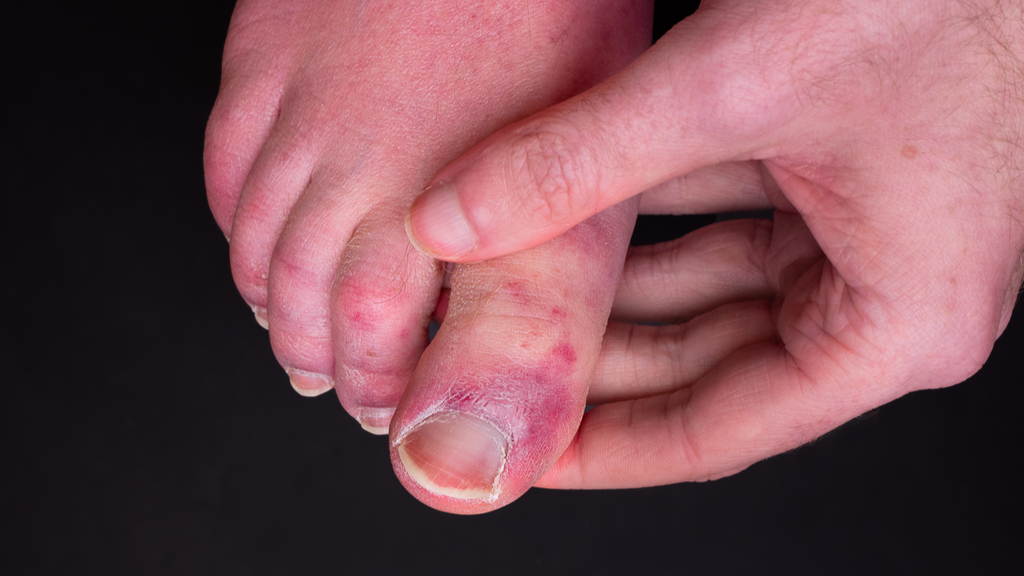We might finally know what causes 'COVID toes'

A mysterious condition known as "COVID toes" may finally have an explanation.
It turns out that the frostbite-like rashes that appear on a person's toes after they catch COVID-19 may be a sign of a runaway immune response in which the body attacks its own tissues, a new study finds.
Cases of COVID toes started cropping up in the early days of the pandemic, and at the time, scientists had a few ideas as to why the condition manifested, Live Science previously reported. For instance, some dermatologists suggested that the telltale skin sores and bumps, known as pernio or chilblains, were caused by inflammation; others thought they might result from small blood clots in the toes.
Other viral diseases, such as measles, can cause skin rashes, so it wasn't necessarily surprising that COVID-19 could, too. But now, the results of a new study, published Oct. 5 in the British Journal of Dermatology, hint at why the reddish-purple papules pop up on the toes and sometimes the fingers.
Related: 20 of the worst epidemics and pandemics in history
For the new study, the team recruited 50 patients who were referred to the dermatology department of Saint-Louis Hospital in Paris after developing chilblain-like lesions for the first time; all of the patients were admitted during April 2020, near the start of the pandemic.
The researchers found that most of their study participants carried high levels of autoantibodies, proteins generated by the immune system that inadvertently attack the body's own tissues. They also found evidence that, compared with healthy individuals, the participants showed rampant activity of proteins called type 1 interferons, which switch on pathogen-fighting genes in immune cells. While these interferons help fight off viruses, human cells can end up suffering collateral damage in the process.
Get the world’s most fascinating discoveries delivered straight to your inbox.
The study participants also showed signs that the lining of their blood vessels had been damaged, which also may have contributed to the appearance of the purple rashes on their toes, the authors noted.
These findings fall in line with those of a very small study published in 2020 in the journal Dermatopathology, The New York Times reported. The study included only three patients, but it hinted that the trio developed toe rashes due to a strong interferon-driven immune response. This fiery immune response might help ward off the coronavirus, but it also may have resulted in the lingering rashes, the authors suggested in their report.
At the time of the study, nearly 60% of the patients showed symptoms that were consistent with mild COVID-19, such as loss of smell or coughing, but all were negative for the virus on a PCR test. In general, COVID toes usually appear one to four weeks after a person contracts SARS-CoV-2,the virus that causes COVID-19, and the rashes can sometimes linger for months, The Guardian reported. So it's not surprising that someone would test negative for COVID-19 despite having COVID-related rashes on their feet, considering the rashes might emerge after the virus has been cleared from their system.
(For context, the three participants in the 2020 Dermatopathology study also tested negative for COVID-19 at the time of the research.)
Besides the coronavirus, other triggers of chilblains include diseases like lupus, which none of the study participants had; and exposure to cold, which would be unlikely in springtime, the authors noted in their report. Given that cases of chilblain-like rashes ebbed and flowed with the waves of COVID-19 in 2020, overall, the available clues hint that their patients' rashes were linked to COVID-19 infection, the authors wrote in their report.
The team collected blood samples and skin biopsies from the patients and examined them for various signs of immune system activation. They also compared these samples to samples collected from healthy individuals and people who experienced seasonal chilblains, caused by cold weather, prior to the pandemic.
They found a significant overlap in the results from presumed COVID-toe patients and the seasonal chilblain patients, in that both carried autoantibodies and showed signs of heightened type I interferon activity. This finding suggests that the conditions arise from the common mechanism of a runaway immune response, although the immune response itself gets set off by a different trigger in each scenario, the authors wrote.
Podiatrist Dr. Ivan Bristow told The Guardian that, for most people, COVID toes eventually clear up on their own, without the need for medication. That said, for those whose rashes are slow to heal, the new study could point toward helpful treatments, he said. For example, per the study's results, local or systemic anti-inflammatory agents, such as steroids, may be effective in treating COVID toes, The New York Times reported.
Originally published on Live Science.

Nicoletta Lanese is the health channel editor at Live Science and was previously a news editor and staff writer at the site. She holds a graduate certificate in science communication from UC Santa Cruz and degrees in neuroscience and dance from the University of Florida. Her work has appeared in The Scientist, Science News, the Mercury News, Mongabay and Stanford Medicine Magazine, among other outlets. Based in NYC, she also remains heavily involved in dance and performs in local choreographers' work.


